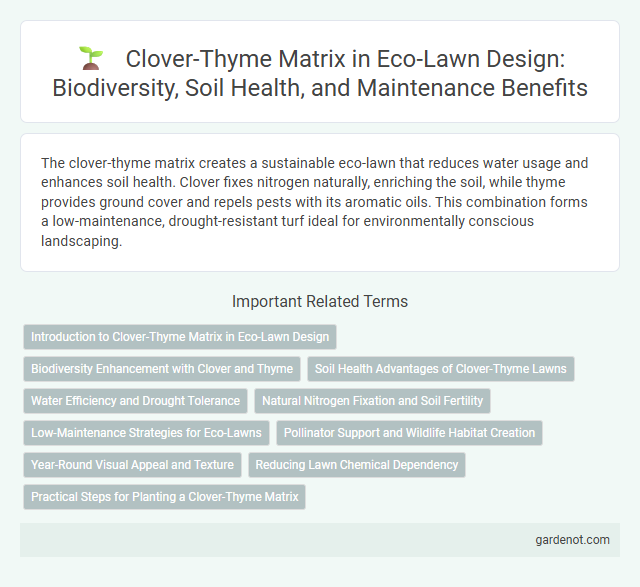The clover-thyme matrix creates a sustainable eco-lawn that reduces water usage and enhances soil health. Clover fixes nitrogen naturally, enriching the soil, while thyme provides ground cover and repels pests with its aromatic oils. This combination forms a low-maintenance, drought-resistant turf ideal for environmentally conscious landscaping.
Introduction to Clover-Thyme Matrix in Eco-Lawn Design
The Clover-Thyme matrix in eco-lawn design combines nitrogen-fixing clover with drought-resistant thyme, creating a resilient, low-maintenance ground cover. This matrix improves soil health, reduces the need for chemical fertilizers, and supports pollinators like bees and butterflies. Integrating clover and thyme enhances biodiversity while providing a durable, eco-friendly alternative to traditional turfgrass.
Biodiversity Enhancement with Clover and Thyme
The Clover-thyme matrix significantly boosts biodiversity by providing a rich habitat for pollinators and beneficial insects, supporting ecosystem health. Clover's nitrogen-fixing ability enriches the soil, promoting plant diversity and resilience, while thyme offers ground cover that reduces soil erosion and attracts a variety of pollinating bees and butterflies. This green matrix enhances ecological balance, making eco-lawns sustainable and vibrant.
Soil Health Advantages of Clover-Thyme Lawns
Clover-thyme lawns enhance soil health by naturally fixing nitrogen through clover's symbiotic bacteria, reducing the need for synthetic fertilizers. The dense root systems of both clover and thyme improve soil structure and increase organic matter, promoting microbial diversity and water retention. This combination also suppresses weeds, minimizing soil disturbance and maintaining long-term soil vitality.
Water Efficiency and Drought Tolerance
The clover-thyme matrix forms a resilient ground cover that significantly boosts water efficiency by reducing evaporation and enhancing soil moisture retention. This combination exhibits exceptional drought tolerance through clover's nitrogen-fixing ability and thyme's deep root system, promoting sustained growth with minimal irrigation. Together, they create an eco-lawn solution that thrives in arid conditions while lowering overall water consumption.
Natural Nitrogen Fixation and Soil Fertility
The clover-thyme matrix enhances natural nitrogen fixation through symbiotic bacteria in clover root nodules, significantly boosting soil fertility. This nitrogen enrichment reduces the need for synthetic fertilizers, promoting sustainable eco-lawn growth. Thyme's dense ground cover supports soil structure and moisture retention, further improving soil health and resilience.
Low-Maintenance Strategies for Eco-Lawns
Clover-thyme matrix eco-lawns integrate drought-resistant clover species with low-growing thyme varieties, minimizing the need for frequent watering and mowing. This plant combination enhances nitrogen fixation and natural weed suppression, reducing reliance on chemical fertilizers and herbicides. Establishing a clover-thyme matrix promotes resilient, sustainable turf with significantly lower maintenance requirements compared to traditional grass lawns.
Pollinator Support and Wildlife Habitat Creation
The clover-thyme matrix in eco-lawns significantly enhances pollinator support by providing continuous nectar sources that attract bees, butterflies, and other beneficial insects essential for ecosystem health. This diverse plant combination promotes wildlife habitat creation by offering shelter and food for various small mammals, birds, and invertebrates within urban and suburban landscapes. Incorporating clover and thyme reduces the need for chemical inputs, fostering a sustainable environment that supports biodiversity and soil vitality.
Year-Round Visual Appeal and Texture
The Clover-Thyme matrix creates a resilient eco-lawn with vibrant green hues and delicate purple blossoms that provide year-round visual appeal. Its dense foliage offers a soft, textured surface that enhances aesthetic interest while supporting pollinators and improving soil health. This combination ensures a sustainable, low-maintenance lawn that remains attractive across all seasons.
Reducing Lawn Chemical Dependency
The Clover-thyme matrix significantly reduces lawn chemical dependency by naturally suppressing weeds and enhancing soil nitrogen levels through clover's nitrogen-fixing ability. Thyme's dense ground cover inhibits pest growth, minimizing the need for synthetic pesticides. Together, this eco-friendly combination promotes lush, resilient lawns with fewer herbicides and fertilizers.
Practical Steps for Planting a Clover-Thyme Matrix
Prepare soil by removing weeds and loosening it to a depth of 4-6 inches, ensuring proper drainage. Sow a balanced mix of white clover and creeping thyme seeds, aiming for a ratio of about 70% clover and 30% thyme to promote ground coverage and drought resistance. Maintain consistent moisture for the first 3-4 weeks after sowing, avoid heavy foot traffic during establishment, and mow lightly to encourage dense growth and suppress weeds.
Clover-thyme matrix Infographic

 gardenot.com
gardenot.com